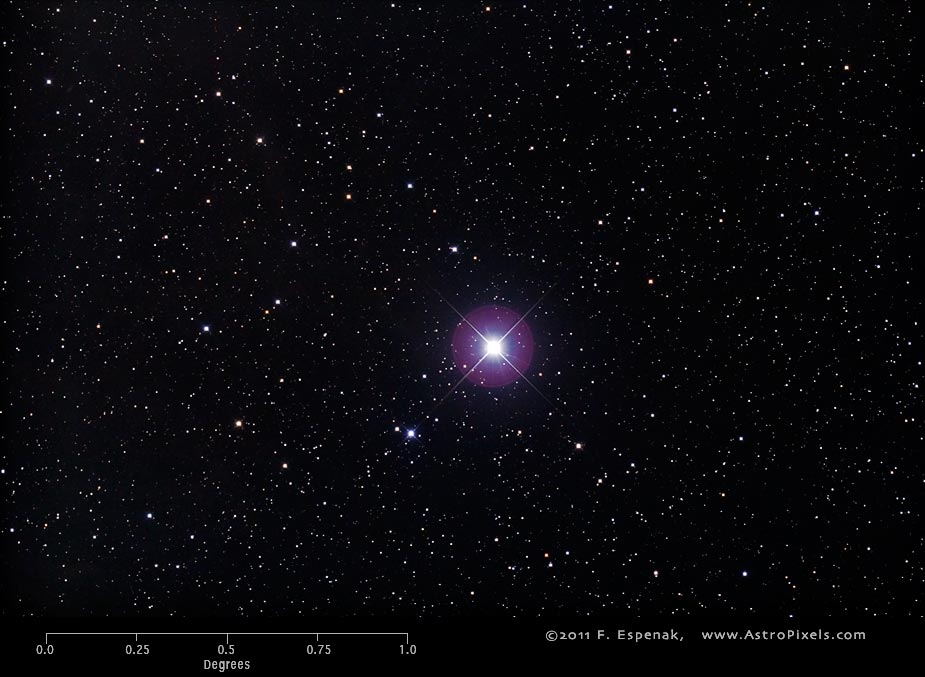Polaris
Polaris or Alpha Ursae Minoris (Alp UMi) is the brightest naked eye star in the constellation Ursa Minor. With an apparent magnitude of 1.97v, Polaris the 46th brightest star in the entire sky (see: 50 Brightest Stars ). Its absolute magnitude is -3.64 and its distance is 447.0 light years.The Equinox J2000 equatorial coordinates are RA = 02h 31m 48.7s, Dec = +89° 15' 51".
Polaris has a spectral type of F7Ib-II, a surface temperature of 7200° Kelvin and a luminosity 2500 times the Sun. It has a mass of 6.5 solar masses and a diameter 46 times the Sun.
The image above shows the uncropped view of Polaris (North is up) through the Takahashi E-180 Astrograph.
Polaris A is a bright giant (spectral type F7 II) of 6.5 solar masses. The two smaller companions are Polaris B, a 1.5 solar mass F3V main sequence star orbiting at a distance of 2400 AU, and Polaris Ab, a very close dwarf with an 18.5 AU radius orbit. There are also two distant components Polaris C and Polaris D.
Polaris B can be seen even with a modest telescope and was first noticed by William Herschel in 1780. In 1929, it was discovered by examining the spectrum of Polaris A that it had another very close dwarf companion (variously Polaris P, Polaris a or Polaris Ab), which had been theorized in earlier observations. In January 2006, NASA released images from the Hubble telescope, directly showing all three members of the Polaris ternary system. The nearer dwarf star is in an orbit of only 18.5 AU (2.8 billion km, about the distance from our Sun to Uranus) from Polaris A, explaining why its light is swamped by its close and much brighter companion.
Polaris a classic Population I Cepheid variable. Since Cepheids are an important standard candle for determining distance, Polaris (as the closest such star) is heavily studied. The variability of Polaris had been suspected since 1852 and was confirmed by Ejnar Hertzsprung in 1911. Around 1900, the star luminosity varied 8% from its average (0.15 magnitudes in total) with a 3.97 day period; however, the star's heat is at a low level. Over the same period, the star has brightened by 15% (on average), and the period has lengthened by about 8 seconds each year.
Research reported in Science suggests that Polaris 2.5 times brighter today than when Ptolemy observed it, changing from third to its current second magnitude. Astronomer Edward Guinan considers this to be a remarkable rate of change and is on record as saying that "If they are real, these changes are 100 times larger than [those] predicted by current theories of stellar evolution."
During the present era, Polaris lies nearly in a direct line with the axis of the Earth's rotation axis. As the North Star, Polaris stands almost motionless in the sky, and all the stars of the Northern sky appear to rotate around it. This makes it an excellent fixed point from which to draw measurements for celestial navigation and for astrometry. The moving of Polaris towards, and in the future away from, the celestial pole, is due to the precession of the equinoxes. The celestial pole will move away from Polaris after the 21st century, passing close by Gamma Cephei by about the 41st century. Historically, it was close to Thuban around 2500 BCE. During Classical Antiquity, the celestial pole was closer to Kochab than to Polaris. It was about the same angular distance from either Kochab than to Polaris by the end of Late Antiquity. The Greek navigator Pytheas (ca. 320 BCE) described the celestial pole as devoid of stars. As one of the brighter stars close to the celestial pole, it was still used for navigation at least from Late Antiquity,and described as "always visible" by Stobaeus (5th century). Polaris could reasonably be described as stella polaris from about the High Middle Ages.
At present, Polaris 0.7° away from the pole of rotation (1.4 times the Moon disc) and hence revolves around the pole in a small circle 1.5° in diameter. Only twice during every sidereal day does Polaris accurately define the true north azimuth; the rest of the time it is only an approximation and must be corrected using tables or a rough rule of thumb. The best approximation was made using the leading edge of the constellation Ursa Major as a point of reference. The leading edge (consisting of the star Dubhe) is referenced to a clock face and the azimuth of Polaris worked out for different latitudes.
The description above is based on the Polaris entry in Wikipedia.For more information about Polaris, see Stars (Jim Kaler).
Technical Details
- Object: Polaris
- Other Names: Alpha Ursae Minoris, HR424, HD8890, HIP11767
- Object Type: bright star
- Object Data: Apparent Magnitude = 1.97v, Absolute Magnitude = -3.64, distance = 447.0 light years
- Object Position (Equinox J2000): RA = 02h 31m 48.7s, Dec = +89° 15' 51", Constellation = Ursa Minor
- Date/Time: 2011 Dec 29 at 07:21:23 UTC
- Location: Bifrost Astronomical Observatory, Portal, AZ
- Mount: Astro-Physics 1200GTO
- Telescope: Takahashi Epsilon 180 Hyperbolic Astrograph
- Camera: Canon EOS 550D (Rebel T2i) (modified with a Baader UV/IR filter)
- Field of View: 1.70° x 2.56° at 1.7 arc-sec/pixel (web version: 10.0 arc-sec/pixel)
- Exposure: 2 x 180s, f/2.8, ISO 800
- File Name: Polaris-01w.jpg
- Processing (Adobe Camera Raw): Graduated Filter, Vignetting Correction, Noise Reduction, White Balance, Curves
- Processing (Photoshop CS5): Average Images, Curves, Noise Reduction
- Original Image Size: 3454 × 5179 pixels (17.9 MP); 11.5" x 17.3" @ 300 dpi
- Rights: Copyright 2011 by Fred Espenak. All Rights Reserved. See: Image Licensing.
